Learn how to strategically find your best customers and target them more effectively using data.
If you do not see the results you expected from your marketing campaigns, there could be two big reasons.
- Your ad copy is sending the wrong message to the audience your targeting.
- You’re targeting people that will never click or convert.
Finding Your Target Market
I believe that few advertisers are using a data-driven, step-by-step process to do it well. There’s a good reason why.
There’s not a lot of actionable material out there on how to identify and target your perfect customer online.
One of my methods and the one I’m going to explain today is to use ad copy to provoke an action from my ideal customer. I can track the positive effects, learn about those users, and build a model of those users that I use to target similar people.
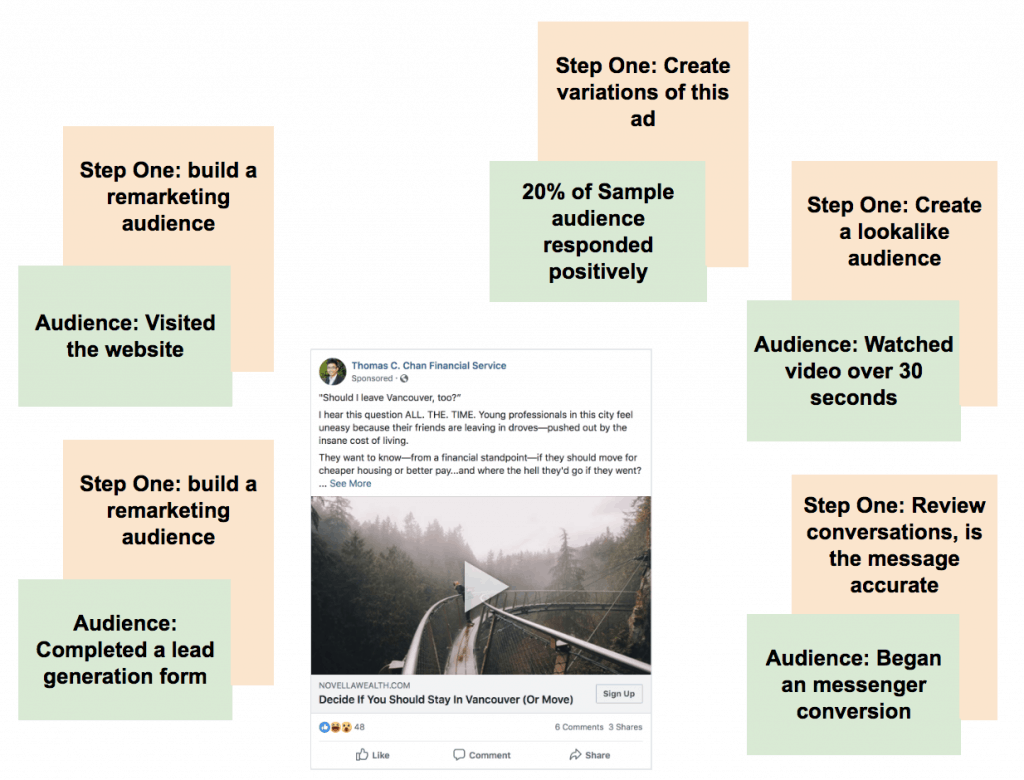
Using this method, I can deliver highly relevant messages to very targeted groups of people, which result in cheaper conversions and higher conversion rates.
If you were to rely on Google or Facebook ad targeting to identify your target customer, would it work? Could interest targeting or keywords alone determine your target customer and then motivate them into action? Sometimes, but not every time.
Although the ad platforms are great at telling us what people are interested in they don’t tell us why.

Where To Begin
Understand the factors that can affect your ad campaign.
Targeting limitations
Facebook, LinkedIn, and Google are incredibly useful ad platforms because they are designed to allow person-specific targeting; however, they have their limitations.
Usually, the targeting options are an indicator of broader interests, but they don’t show an advertiser what a person wants or likes. Someone might show an interest in the Prime Minister, but it doesn’t mean they’re a supporter. It could just mean they have an interest, positive or negative in what the Prime Minister is doing.
Likewise, you may discover that 95% of your customers are Harry Potter fans, but that does not mean that 95% of Harry Potter fans are your customer.
Targeting a specific interest or keyword is unlikely to deliver you the customers you want unless you can combine it with the right message.
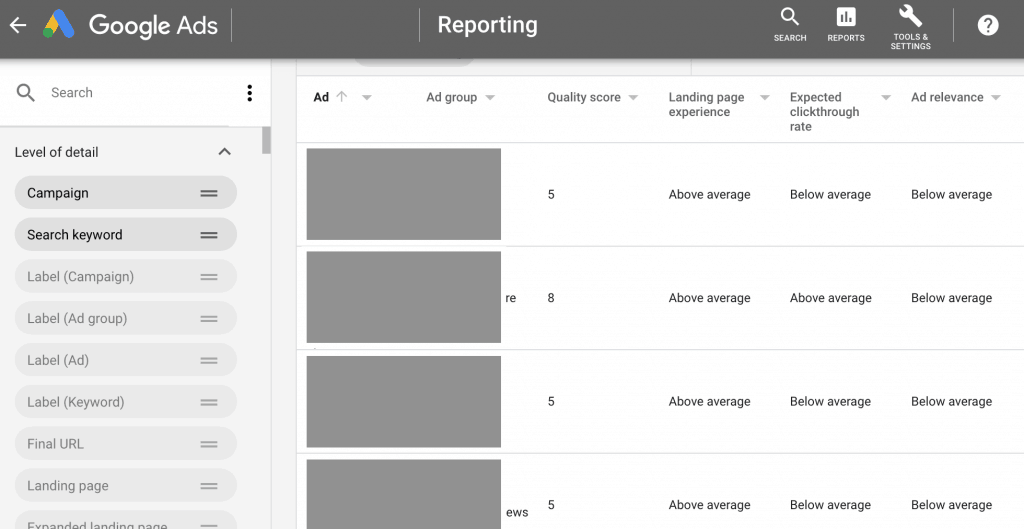
Our method is to test a message against various audience groups that we have built to resemble our customer personas.
If the above chart would be useful for your audience planning, you can download it here.
We want to see which variables best leads a customer to our objective. Before we do that, we need first to identify the customer groups we are targeting.
In 2013, Cambridge University researchers Michal Kosinski, David Stillwell and Thore Graepel published an article on the predictive power of Facebook data by using data gathered through online personality tests.
The paper showed that they could distinguish between black and white respondents, 95% of the time based on an audience built only from Facebook “likes.” They found they could distinguish men from women 93% of the time and could even distinguish people who identified as gay men from men who identified as straight 88% of the time.
Using the principles of this research, we can match a customer persona to an audience based on how they respond to the message in an ad.
Know the platforms
The ad platforms are motivated to deliver relevant ads to their audience, and advertisers are penalized with high costs and poor reach if they don’t do their bit.
Facebook, Google, and LinkedIn must ensure that their users are delivered a stream of new relevant content, or they risk annoying those users and losing them.
The platforms determine if the content is relevant to the user through several methods, including user engagement metrics and website pixel data. The ad platforms collect user data from their millions of website pixels and app partners to group people and help show ads their algorithm believes are relevant.
While all platforms are slightly different, they all prioritize ads based on the ads relevant to the audience and the expected actions of the user.
In the world of advertising, it’s broadly intuitive what ‘relevant’ means. Advertisements for children’s toys don’t run in the middle of a late-night movie, and funeral insurance ads don’t run in the middle of children’s programs. But beyond simple demographics, the ad platforms algorithm uses many indicators to deem what’s ‘relevant’:
- Specific personality types
- Purchase behavior
- Brand awareness
- Expected actions
- Perceived brand quality
Google, Microsoft, and Facebook all have metrics to help you better understand if you’re delivering a relevant ad to an appropriate audience.
If you notice your ad is performing poorly, you can use these reports to see if you should focus your attention on the ad copy, the landing page, or the targeting. We’ll look at this in more detail later.
We are using Google & Facebook ads to build a hyper-relevant root audience based on user activity.
This is a quick and dirty list of the data points that we could use to infer interest in our service and build a root audience:
- Pages of a website the user visited
- Events they triggered like a purchase or added to cart
- Engagement with our app
- Watched one of our videos
- Submitted a lead form
- Opened an instant experience
- Sent us a message
Additionally, when someone shares information like their phone number, email address or even connects to WiFi router owned by a business, that business can match it to the person’s Facebook profile. We can also use data from outside of the platform to create our root audience.
Once we have built a custom audience, we can use the analytics tool to learn more about the people in the audience their motivations, and what they respond to.
We can then use those same custom audiences to create lookalike audiences and find more people that look like our root audience. This allows us to scale much quicker and cheaper than before because our relevance will be that much higher.
Step one is first to create a training set. In the beginning, this starts the old fashioned way. We have to research and learn about who is and isn’t our customer.
Research Your Customers and Service
The knowledge you gather is the bedrock of the testing process.
Who, what, where, when, why?
To give you an idea of what you need to identify before you start your ad campaign, I’m going to introduce you to a client of mine. Meet Thomas C Chan.
Identify the challenges
Thomas’s ideal customers are 30-somethings trying to get on the property ladder.
Compared to the average salary Vancouver has some of the highest property prices in the world.
Buying a home in Vancouver seems like an impossible task for most young people, which, in turn, means it creates challenges for Thomas.
For a start:
- How does Thomas identify his customers?
Many Vancouver 30-somethings cannot afford to buy. Targeting them all would be a waste of time and money, so how does he find the ones that could buy? If he targets every 30 years old, he could be penalized by the platform.
- He has to change their belief
Many of Thomas’s target customers believe they cannot buy in Vancouver because of the cost, so don’t even consider it. They may not even know what a wealth advisor does or how Thomas can help and so they wouldn’t reach out to him.
- Most difficult, he needs to motivate them into action
Thomas’s best customers tend to be younger and may not even be considering buying a home. They usually have little interest in what a wealth advisor would have to say.
Which leads us to the next step…
Determine who your customers are
Before you can target anyone, you need to know who your customers are and it’s the data that will tell you if your assumptions are correct.
If you’re promoting a gaming app about racing cars, you may assume that your target audience is young men, but we don’t target customer based assumptions.
A data-led approach may show you that middle-aged women make more in-app purchases, or, older men are cheaper to acquire and play longer.
I break this analysis phase down into three stages,
- A structured heuristic analysis.
- Quantitative analysis of the data sources.
- Finally, qualitative analysis to gain a better understanding of customer motivations.
Heuristic analysis
We start with an experience-based assessment because it’s fast and brings focus to the areas that need your attention. We’re forming opinions and finding areas of interest that we shall seek to validate or invalidate in the qualitative and quantitative research phases.
The experience you have gained from hundreds of hours working on your business means a lot.
You can quickly make predictions about your customers that someone with very little knowledge of your customers could not. But we’re not throwing mud at the wall.
This is an organized process that allows you to uncover an area of particular interest. It’s essential at this stage to include your fellow designers, user experience specialists, and copywriters.
Remember we’re not uncovering facts we’re forming questions.
Use the structured analysis data sheet to guide your heuristic analysis.
Quantitative research
Your analytics data is a great place to research your audience. You’ll want to gather information about your site visitors and more importantly your paying customers.
- What are they in the market for
- What’s their age and gender
- Do they have common interests
- Are their common search queries or keywords they use
- How do they behave on the site
- Are their purchases planned or impulsive
- Do they make recurring purchases
- Is their purchase luxury or necessity
You can find the answers to most of these questions in
- Web analytics tools like Google Analytics
- Google Ads query reports
- The Audience Insights tool in Facebook
- The Google Search console
- SEO tools like SEMRush and Ahrefs
- Customer surveys
The data from your quantitative analysis will reveal what your audience does and how it behaves, but it won’t tell you why your audience behaves in those ways. We use quantitative analysis to focus our attention on what to test.
Qualitative research
Customer observations, interviews, and focus groups are all great sources of qualitative data, but they can’t replace a conversation with your best customers. Pick up the phone, email them, and utilize messenger to start conversions with them.
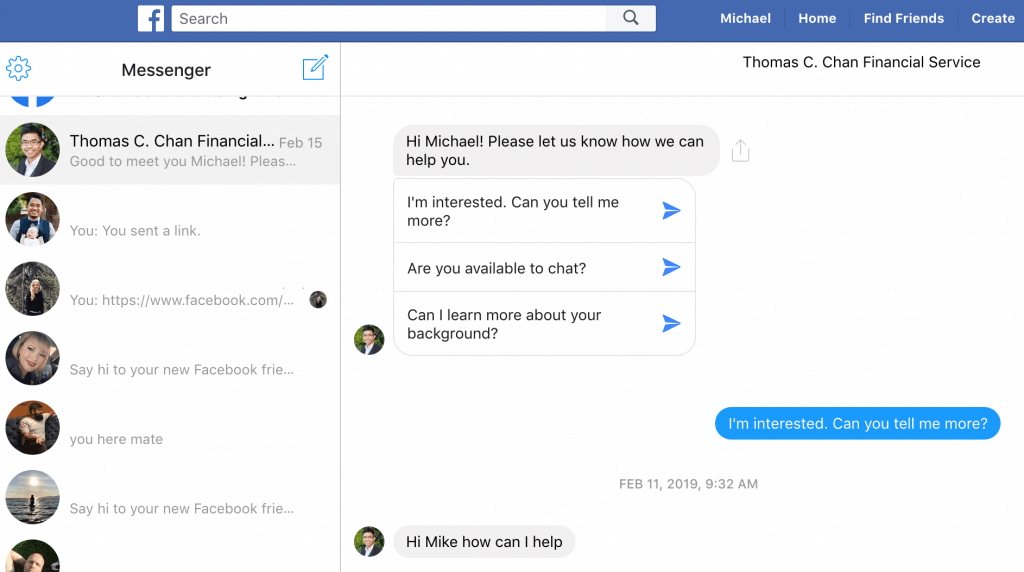
Become your customer
Before you can target anyone, or even put pen to paper, you need to think about who ‘they’ are. Put yourself in their shoes, and consider the following:
- What’s the biggest problem you or your product solves?
- How significant would the change be for your best customer?
- Is the change lasting?
- How does your customer measure success?
- What’s the risk to your customer if they do nothing?
- Who does your offer solve a problem for?
Talk to your current customers
This can be done by a phone call, email survey, or any feedback tool that you feel comfortable using. Ask them the following questions:
- Where do they work and what is their job title?
- Before they decided to work with you, what was the biggest problem that they were hoping to fix?
- Did they feel like there was something that you offered that others couldn’t or wouldn’t provide?
- What was their biggest hesitation when deciding on you and how did they overcome that hesitation?
- Which social media platforms are they most active on?
- What are their hobbies and interests outside of work?
- What websites or blogs did they use for research?
Create an ideal customer avatar
If you haven’t already, create many customers avatars. You’re are not limited to one.
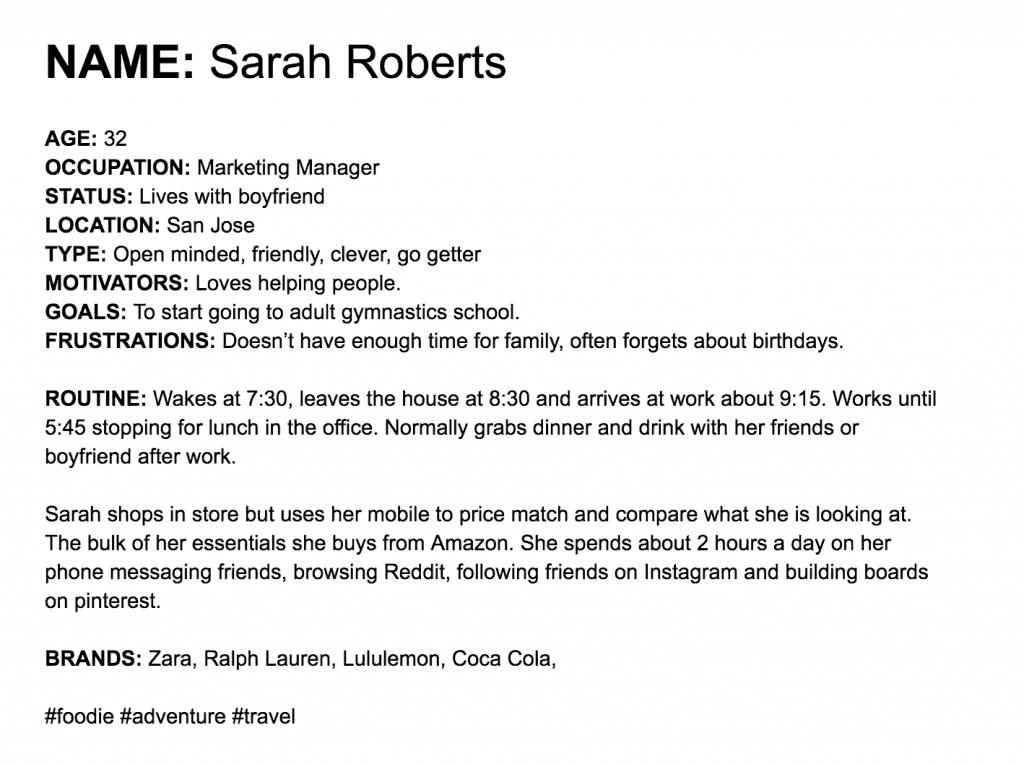
It’s better to have many accurate personas rather than one general persona.
- What are their interests?
- Where do they spend their time online?
- What are their concerns?
- Why would they work with you?
- What is it that drives them to buy your products and remain loyal over a long time?
You can use the customer persona worksheet to help.
Writing Your First Ad
Using the data you have collected and the customer avatars you created you’re going to first define your target market.
Is this ad for awareness or branding? Are they “aware” of what your business or what you sell?
Alternatively is your target audience “in-market”?
Create personalized messages
The researchers of a National Academy of Sciences study found that by micro-segmenting their audience and delivering ads based on the user’s psychologies, they could significantly alter the behavior of the target user.
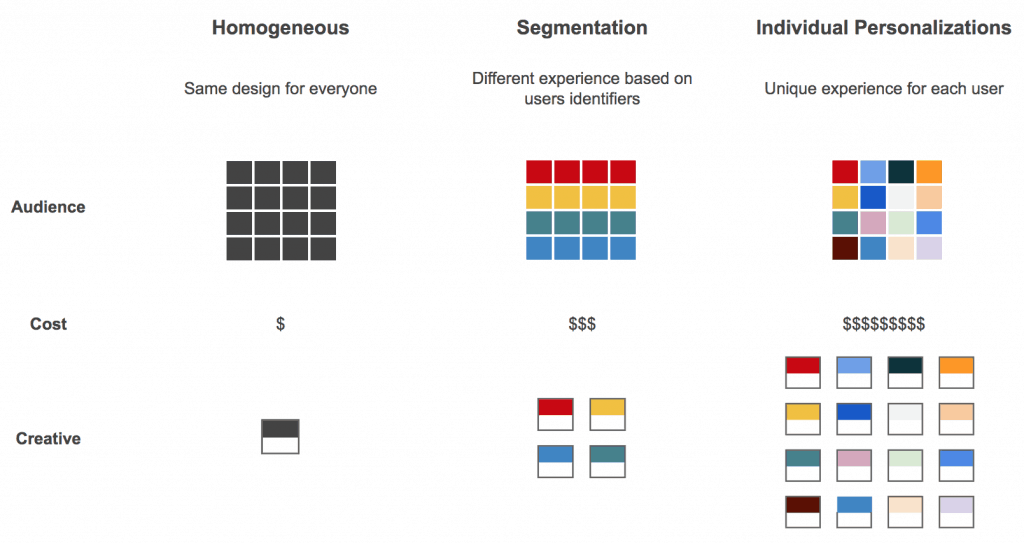
The research suggests that by segmenting the audience and delivering a message specific to their psychographic attributes, we have more significant influence over their actions.
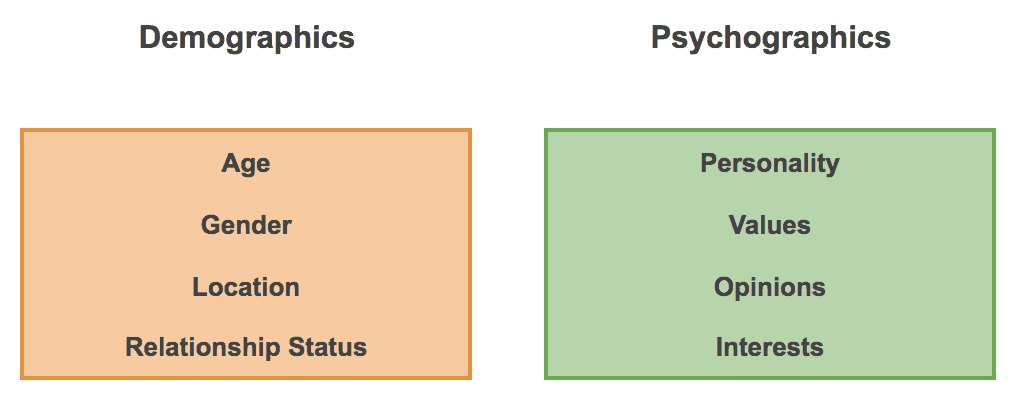
Test-round One
For your first round of testing, you will need four ad variations.
We are going to put these variations to our audiences and see which they respond to positively. Once we have a winner, we’ll re-test.
Review your notes from your customer research. I suggest picking a theme for your ads. Rather than picking them from thin air, try to align your themes with your research.
Perhaps focus on the emotions of your prospect, the unique selling points of the offer, or, the questions a problem-aware prospect would ask.
Click to download the Ad Variation Template
Your service or product may only have one function, but that one function solves multiple different problems. For example, Thomas Chan Financial advises his customers which funds they should invest in. But he solves money problems:
- Reducing taxable income
- Saving for a house
- Preparing for retirement
- Confusion around financial planning
- Reducing debt
Evaluate your offer
To write your ad copy, you need to understand why someone would choose you over your competitors, consider the following:
- How do you currently solve any problems your customer experiences?
- What does your offer include?
- How much does it cost?
- How do you deliver it?
- What kind of support do you offer?
- Do you have ideas for improving your program, delivery, or support?
If you need more help around writing ad copy I’ve written an entire post about how to use data to write a great ad. It’s packed with tips and tricks.
Thomas started with four key pain points that he believed would motivate an active prospect:
- You don’t think you can afford to stay in Vancouver
- Many young people are thriving in Vancouver
- You are scared of your financial future
- Understanding your taxes could solve your financial risks
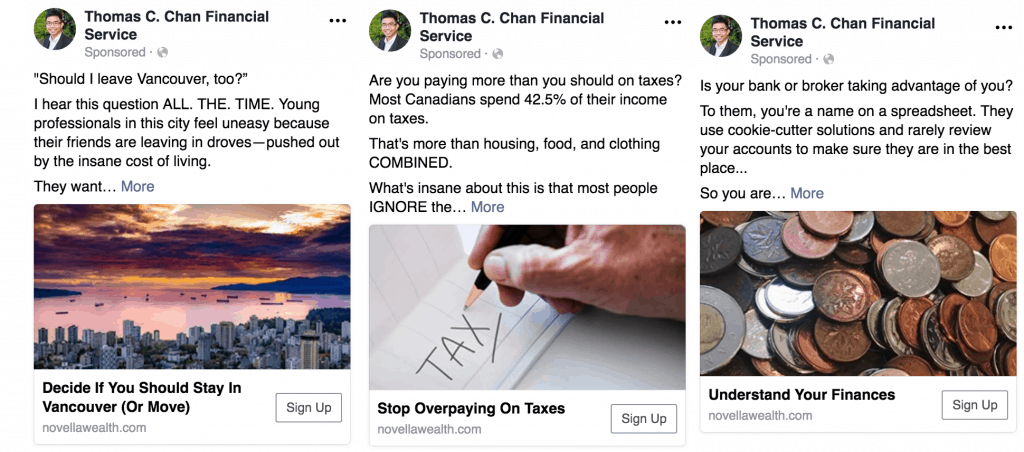
Targeting Process
Create your datasets to define your target market.
Before we can use Facebook, LinkedIn, or Google ads to create a lookalike audience, we must first get enough people to reveal what it is about them that identifies them as our ideal customers.
If you’re trying to use an action like watching a video, to predict a second action like converting into a customer, it’s much easier if you can compare the attributes of a non-converters alongside the converters. That’s what we are going to do next.
Don’t make assumptions
What are the factors that influenced your last major purchase?
- You could visit the store. You needed it fast or perhaps you wanted to touch the product, speak to an expert and get some advice?
- You were on a limited budget, and wanted the cheapest option available?
- You wanted reliability, so went for unlimited warranty, replacements or money back quarantines?
- Your trusted them. You have a level of trust and respect for the brand and what they promise to deliver?
Realistically, there are only a few things that would have influenced your decision. We want to identify what those factors are for your business.
Most businesses need only focus on two core factors and two to three secondary factors. The problem is that many companies are focusing on the wrong ones, without properly taking the time to understand what’s essential to their customers.
People choose to work with Thomas because:
- He’s local to where they live
- He specializes in 25 – 35-year-olds
- He speaks English and Cantonese
For service-based businesses like Thomas’s, location is critical. So we started by building out his campaign with the core focus around the location of his customers.
We need to consider the influencing factors because this is what we use to form our first sample audience for our initial ad copy tests.
Remember, this is the first round of testing we want our audience reasonably broad.
Build your first audience based on location
Following our research and Thomas’s customer requirements, we knew his target audience was only in Vancouver and between 30 and 50. That’s the audience we started with.
This is known as the ‘Carpet Bomb.’ It seems counterintuitive because most marketing strategies focus on targeting a specific group of people. However, the magic of Carpet Bombing lies within targeting as many people as possible and retargeting them with more accurate messaging based on their engagement.
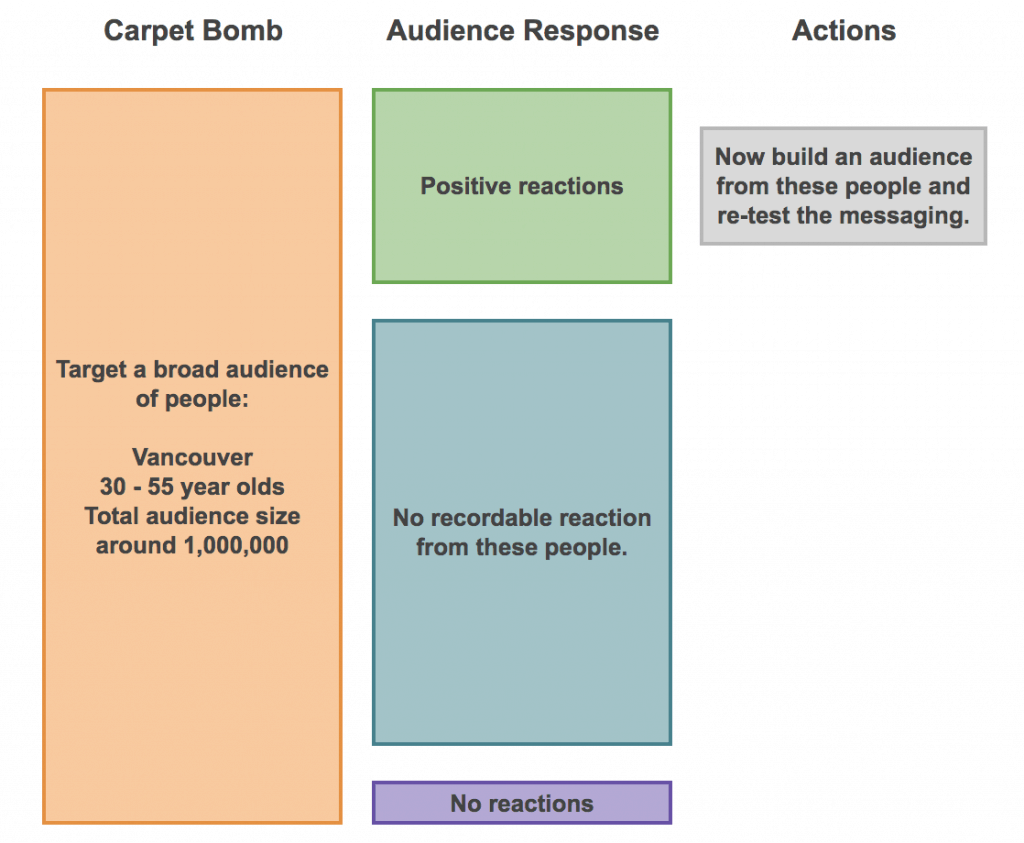
If you’re business only services customers in a small city, you can get away with grouping all those people together in one sample audience, but you really don’t want to add any additional layers of targeting on a small audience.
If you’re selling your product nationally, you may have to segment your audience a little further, but typically I wouldn’t run a Facebook campaign with an audience under a million. You need enough data for the platform to optimize.
Using your qualitative research, I suggest finding a city with high conversion rates and a high volume of sales to target.
Segmenting large audiences
If location is irrelevant to your service but age or gender is a crucial factor for your customers, you should segment your audience by age or gender instead.
By segmenting an audience like this, you can optimize the value of that audience. For example, if 35 – 44 year olds are worth more to you than 25 – 34 year olds we can set our target cost per result relative to that.
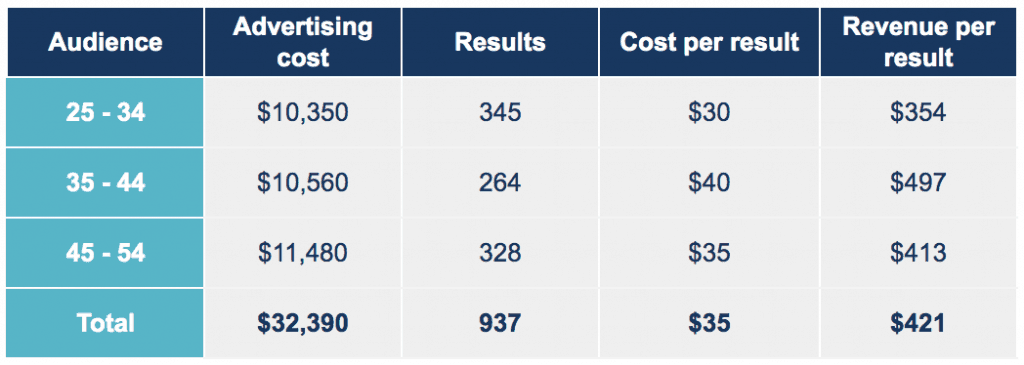
Calculate your reach
Thomas’s customers are 25 – 45 and live in the greater Vancouver area. According to Facebook’s estimated reach calculator, that means we have about 700,000 people we can target.
It’s not ideal, but it’s a start. If Thomas could service customers a little further out of Vancouver or outside of 25 – 45 year olds I would have preferred to expand the geo-targeting and get a million people, but it wasn’t possible.
Your reach is essential to understand. The platform whichever it is, Google, Microsoft, LinkedIn, Facebook will estimate the size of your potential audience.
Within that audience, there will be various groups.
- X% of people are regularly active on the platform and have high conversion rates. The advertisers are competing for these people
- X% of people are typically frequently on the platform but rarely convert. Advertisers don’t want these people, and they’re expensive.
- X% have high conversion rates but are rarely online. Only the most competitive advertisers are after these people.
And there are many more in between.
But bear in mind, a simple bid change or target cost per result change can massively impact your reach and ultimately your performance.
Testing Phases
You can iterate through this process as many times as you need.
Set up tracking
To accurately measure your campaigns, make sure you have the following set up correctly:
- All relevant tracking pixels for the platforms you’re using (Google, Microsoft, Facebook, Linkedin, etc.)
- Web Analytics tools (e.g.Google Analytics)
- Any tool-specific reporting (e.g. Facebook attribution reporting and analysis)
Launch round one
In round one, we want to understand what messaging motivates our target audience to take action.
If the pain point in our ad copy isn’t clear or not really of concern to people, we might find we get no clicks. Alternatively, if the message is confusing or misleading, we may get lots of clicks, but no conversions.
In these early testing stages, I recommend using Facebook and LinkedIn lead ads or messenger ads.
Lead ads are great because you’re asking the customer to commit something of value. They are only giving up their email address if finding out more is of importance to them.
Messenger ads also help you refine your ad copy and ensure your offer is appropriately described. If people start responding to the advertisements and but it’s not clear to them what you offer, it’s time to adjust the ad copy.
Because we were using messenger ads in round one, we found out quickly that our message was wrong. People were messaging and asking for a service we didn’t offer.
Analyze your data
There are some key metrics you will want to review:
- Like, shares and comments
- Clicks, impressions, and reach
- Cost per click
- Landing page views
- Lead submits
- Cost per lead
- Completed video views
You need to have enough data to identify a winner before you can take action but bear in mind we are not looking for a statistically significant result. We are using the ads to identify a root audience and the pain points they associate with most of our ad copy.
If you are looking for a post on A/B testing, read my how to A/B test here.
So, which ad copy worked for Thomas? He found that #1 “You don’t think you can afford to stay in Vancouver.” was the winner. When you have a proven winner, you can move on to round two.
Build your first lookalike
Based on your results, you can create your first custom audiences and then lookalike audiences from them.
If you used a standard ad format that drove people through to your website or app, you can build your custom audience based on the pages they visited or events they triggered.
If your ads contained a lead form, video or if you used an instant experience, you can use engagement with that to build your custom audience as well.
If you build your custom audiences at this level, you’re creating audiences that are dialed into the message in your ads
Once you have a custom audience you will be prompted to create your lookalike audience. I suggest creating three to four lookalikes, 0 – 3%, 3 – 6% and 6 – 9%. You’ll have to tweak this because remember we want our audience over a million.
Go forward to round two
Now you need to get creative with your ad copy. You have created several audiences to target, and you can now create new ads and messaging more appropriate to that audience.
We’re going to target each audience with researched messages to identify three factors:
- Who the active people are
- What actions they take
- What messages motivate them into action
We can repeat this whole process many times over for different actions and audiences. We’re refining, tailoring, and nurturing the audience.
Keep refining
Your demographic reporting will tell you who is buying; psychographic targeting will say to you why they’re buying. By monitoring your target market’s interests, you’ll be able to target them more effectively, learn more about who they are, learn why they buy your service, and, what motivates them to purchase.
Templates Used in This Post
Ad variation template
Customer persona worksheet
Structured analysis data sheet
This post is part of a series to help marketers better understand their data. If you would like to see changes in your targeting and testing process, it begins with a conversation. Reach out to me at mike@knowndigital.com.